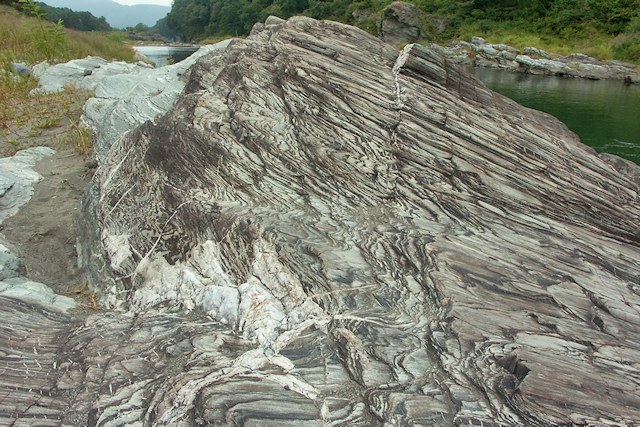By definition, schist is a medium-grade metamorphic rock with medium to large, flat, sheet-like grains that lie in a preferred parallel orientation. It is defined by having more than 50% platy and elongated minerals. These flat, platy minerals include: micas, chlorite, talc, hornblende, graphite, and others. The names of various schists are derived from their mineral constituents. Most schists are mica schists, but graphite and chlorite schists are also common.
The individual mineral grains in a schist are drawn out into flaky scales by heat and pressure, and can be seen with the naked eye. Schists are characteristically folliated, which means that the individual mineral grains split off easily into flakes or slabs. In fact, the word “schist” is derived from the Greek word σχίζειν schízein meaning “to split”, which is a reference to the ease with which schists can be split along the planes that the platy minerals lie. Therefore, schists tend to break easily and, although considered a very attractive stone, are rarely used as building materials due to their lack of strength.
 This brings us to the topic of the “Schist Disk” on display in the Cairo Museum. In the Cairo Museum it is labeled as a Lotus Bowl made out of schist. In addition to the “Schist Disk”, there are several dozen other objects in both the Cairo Museum and Saqqara Museum that are made of a similar substance and have all have been labeled as “schist”. These objects have numerous similarities. They are all a dull dark grey, exhibiting no visible mica or plates of any kind. They are all structurally very delicate, thin and most importantly, they all have intricately carved fluted edges. In the case of the “Schist Disk” it appears to be carved into three wing like folds.
This brings us to the topic of the “Schist Disk” on display in the Cairo Museum. In the Cairo Museum it is labeled as a Lotus Bowl made out of schist. In addition to the “Schist Disk”, there are several dozen other objects in both the Cairo Museum and Saqqara Museum that are made of a similar substance and have all have been labeled as “schist”. These objects have numerous similarities. They are all a dull dark grey, exhibiting no visible mica or plates of any kind. They are all structurally very delicate, thin and most importantly, they all have intricately carved fluted edges. In the case of the “Schist Disk” it appears to be carved into three wing like folds.
 All of these “schist” objects are behind glass and poorly lit. There is no chance of examining them by touch or with a magnifying glass. So, are they a schist? Considering their delicate nature, I doubt it. If they were a schist I believe they would have broken apart by now. The actual “Schist Disk” is in fairly poor condition and has undergone a lot of reconstruction, while some of the other fluted edge “schist” objects are intact and in good condition.
All of these “schist” objects are behind glass and poorly lit. There is no chance of examining them by touch or with a magnifying glass. So, are they a schist? Considering their delicate nature, I doubt it. If they were a schist I believe they would have broken apart by now. The actual “Schist Disk” is in fairly poor condition and has undergone a lot of reconstruction, while some of the other fluted edge “schist” objects are intact and in good condition.
What is the purpose of these objects? We can only speculate at this point in time. I doubt the “Schist Disk” was merely a flower bowl. But if it was made to rotate in any manor then I think it would have been made of a substance somewhat more durable than a schist.
So what are they made of? Without being able to really examine the objects, no definitive conclusions can be made. I speculate that it is a very hard, competent rock that can withstand millenniums of lying in the desert beneath the sand. Perhaps a dolerite?
We may never know.
Suzan Moore – Geologist
Born and raised on the prairies of Saskatchewan Canada, Suzan developed a keen interest in nature, rocks and stars at an early age. That passion later led her to pursue a Geology degree with a minor in Astronomy. Suzan has been working as a Geologist in Canada for over 40 years. She originally worked in both mining and regional mapping of granites and metamorphic rocks in northern Saskatchewan and the North West Territories. She has been working for many years as a Sedimentological Specialist in the Oil and Gas industry in Calgary Alberta, specializing in the Jurassic of Western North American.
She has always had an interest in Ancient Egypt and, since her first visit, returns regularly. After a trip to Peru in 2013 she developed a passion for understanding megalithic structures and the rocks they are carved from which led her to explore their implications in Egypt as well. She is currently trying to incorporate how weathering, time and source of the rocks affect the construction and preservation of many of the megalithic structures.
Suzan offers a unique and fresh perspective on the description, consistency and use of the various types of rocks and materials used in the ancient structures here.
The Khemit School is excited to announce that Suzan Moore, who has traveled to Egypt, Peru and Bolivia several times with the “Techno-Spiritual ” Team, which also includes Brien Foerster, Stephen Mehler, Mohamed Ibrahim and Yousef & Patricia Awyan, has accepted our invitation to join the team and accompany us on upcoming adventures!

